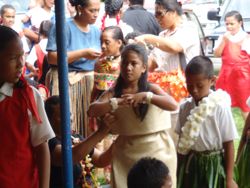November 23, 2010
On the road to Pangai….
We live in the village furthest from the town of Pangai. It’s the only town on the 2 connected islands with stores, a post office, a bank, a high school and other government buildings. It’s a 7-mile journey. We go through 4 villages, including ours, then a very narrow causeway that has ocean on both sides and links 2 islands, then the airport, another town, and, finally Pangai. The narrow road, or causeway, with ocean on both sides can be covered with water during storms, and it’s one lane, with spots occasionally for a vehicle to pull over and wait for another to get by. Sometimes we see men there with their fishing nets. The airport runway crosses the road, so the road has gates that close the road during take-off and landings. It’s not only the main road, but the only road that runs the length of our narrow island.
When we drive we pass stretches of bush, cultivated bush, pastures with a few steers. There is an occasional goat. In the villages the houses all have fences of various materials and quality. It is to keep the pigs out and the dogs are in charge of guarding the house and area. Pigs of all sizes cross the road in front of vehicles, and the vehicles do not slow down. Chickens, chicks, and roosters are roaming, too. In one village we pass the church still in use that was built in the old Tongan style. We pass the place where there is still an old wooden drum/bell. There are shelters where women gather to weave. The Mormon churches have the best fences and usually a beautiful basketball or tennis court, which is also used for dances.
Of course there are banana trees, sometimes with bananas and flower. There are trees with moli, tiny sour oranges, so good squeezed in water with sugar. I have come to learn about the “cotton” tree that has pods with cotton –like material inside that the Tongans used to use for pillows and other stuffing. Coconut trees are everywhere, and they have no season, so are always available—if you can climb and get them.
I love to see the flowers planted in the yards. There are zinnias, roses, marigolds, coleus, strawflowers, bird-of paradise, and amaryllis, to name a few that I recognize. There are also many flowering trees and shrubs, some are so fragrant, and used for leis. Hibiscus is everywhere.
There are people and children to wave to. If you go in the morning you’ll see elementary students walking to school in their uniforms, while older students are getting rides to Pangai to go to the High School. They, too, are in uniform, the colors depending on the school colors. Once in a while there will be a biker.
Too soon the trip is over. I’m always looking for something new to see. I will miss those trips to Pangai!
The Causeway.
Airport. The road is closed.
Banana tree.
Wooden bell.
Moli tree, above. Coconut tree below. It's a long way up!
Assembly for the opening of the school day.




























